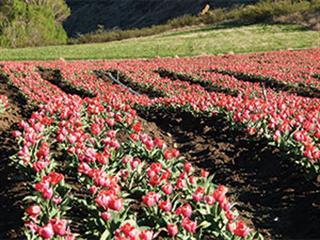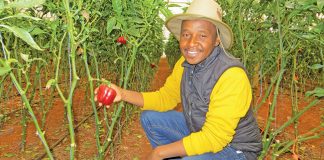
“It has really bitten, and I will never stop, no matter how old I am.” So says Piet Steyn as we walk alongside his 600 000 irrigated flowering tulips on the banks of the Kraai River. He admits that the 1,2ha of tulips that produce 150 000 marketable bulbs a year, is not the first flower spectacle to grace the 812ha family farm The Caves. In fact, he says, his late grandmother Anna Steyn’s terraced gardens had a significant impact on him as a child. ‘’She had a garden filled with flowers, and I think my love for flowers started with her,’’ he recalls. ‘’I wish she was here to see this. I think she would have been really surprised.‘’
An offer not to be missed
In 2006, the manager of the Oak Valley Estate nursery in Grabouw, Ruan Von Wielligh, offered Piet 12 000 tulip bulbs that he had purchased from a failed initiative. Piet jumped at the opportunity. ‘’Ruan said that I would be stupid not to continue the business because the soil temperature and structures are right,’’ he recalls. In fact, his tulip expansion programme was significantly boosted in 2006 by another 150 000 bulbs from Oak Valley Estate on condition that Piet would produce bulbs for its nursery.
In the same year, Piet bought the much needed machinery for tulip production, including planters, harvesters and grading machines from this failed tulip initiative, easing his entry into the capital intensive tulip industry. “I got it all second-hand, so that made it easy for me,’’ he admits. By 2009, another 200 000 tulip bulbs (‘AdRem’ variety) were imported from the Netherlands to boost production.
But Piet admits that this expansion was only possible thanks to his mentor and second client, Daan Barnhoorn, owner of Sassenheim Estate in Plettenberg Bay. ‘’If you don’t have a mentor, forget it. I take photos of bulbs and plants and email them to him, and he will tell me what the problem is,’’ he explains. But most crucial for Piet’s tulip initiative has been the secure and growing market for tulip bulbs from the nurseries at Oak Valley and Sassenheim Estates. ‘’They would like me to provide them with a million bulbs and I now produce 150 000 a year,’’ says Piet.

Piet and Dalena Steyn among their tulips on the farm The Caves in Barkly East, Eastern Cape.
Planting of tulip bulbs
Tulip bulbs are planted in late April or early May when the soil temperature decreases significantly. ‘’I put thermometers in the ground and when the temperature is below 9°C, I start planting,’’ he says. The bulbs are planted two fingers apart from each other, and although denser than recommended, Piet says this enables more effective weed control via spraying with Goltix herbicide before and after the tulips germinate and weeding by workers. However, greater plant density needs more fertiliser. Superphosphate, Potash and LAN are applied at different stages of production to counter competition between plants.
The bulbs lie dormant until cold weather boosts growth. By late August, the first tulip shoots pierce through the ground and Piet says late frosts – besides black frosts – are not a major concern. Nevertheless, he admits it has been a steep learning curve with one of the most serious production threats being the large population of porcupines that he has to combat with a neat 600mm high temporary netting wire fence around his plants.
‘’When I planted the first 12 000 bulbs, I didn’t know what to do. Of the 12 000, only 6 000 remained,’’ he says. ‘’Porcupines can eat a thousand bulbs in a night.’’ Furthermore, 2011 has also been the first year that Piet started using soluble fertiliser (Ultrasol MAP) to counter losses suffered in the past when manual fertilisation resulted in granules being trapped between leaves that not only burned but destroyed the plant.
In fact, any physical damage to plants doubles as an entry point for fungal diseases including Fusarium bulb rot (or zuur) and tulip fire (Botrytis tulipae). ‘’The big thing with irrigation and weeding is that you can’t hurt the leaves; if you do, you run the risk of disease,’’ he explains. ‘’Remember if you hurt the leaves you kill the factory [of the plant].’’
Harvesting bulbs Soon after the tulips flower in mid-September, their blooms are broken off to ensure that the plant’s energy is channelled back to the bulb. Piet stresses that snapping off the flowers by hand is critical, as using any instrument may be catastrophic in terms of spreading disease. ‘’You don’t cut them off with a knife, because if you have disease in one plant then it will infect the others,’’ he says.
Then from about mid-October, the bulbs are mechanically harvested and then stored in crates to be dried. ‘’The bulbs are dried by fans as quickly as possible. If they stay wet they easily get zuur,’’ he says. ‘’This is where your biggest losses can be.’’ When the bulbs are dry, they are graded. The best quality bulbs are packaged for the nurseries at Oak Valley and Sassenheim Estates and the smaller bulbs kept as seed bulbs for future planting.
Interestingly, South African-produced bulbs are preferred by local nurseries, not only for their reasonable prices, but also for their superior quality, says Piet. “South African bulbs have 12 months of energy while the European bulbs they import – for our winter – only have six months’ energy because their winter is in December and ours is in June,’’ he explains. ‘’Our bulbs ensure that the quality of the flower in South Africa is much better.’’
The nurseries at the two estates also return bulbs from which flowers have been produced to augment Piet’s already harvested seed bulbs. ‘’I get the bulbs back from the nurseries, so I carry two stocks – one stock is with the nurseries at the moment and the other is in the ground here,’’ he says. The multiplying of tulip bulbs is critical for the enterprise’s future expansion. The process demands a delicate balance between expansion and production.
‘’I shouldn’t actually sell anything this year if I want to expand next year, but I can’t do that because I need to sell bulbs to cover my costs and supply the nurseries,’’ he admits. ‘’If I want to grow, then I will have to import two containers.’’
Contact Piet Steyn on 045 974 9255, or visit www.greenerthumb.com












